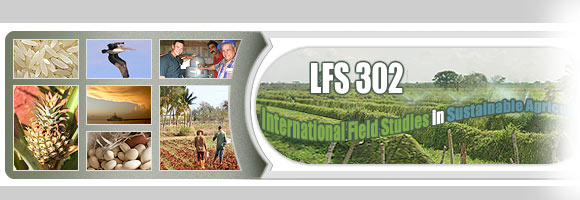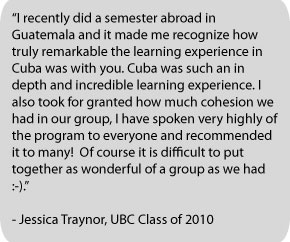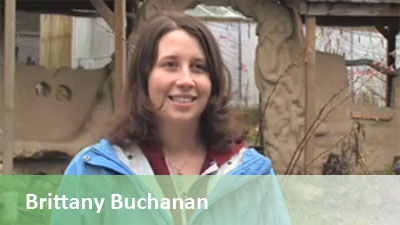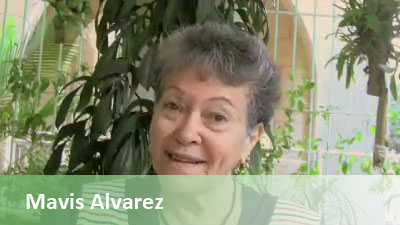
Field Trip Date: Final dates to be confirmed, however, usually leaves for Cuba in the last week of April for three weeks
 Interested students are advised to contact the instructor. See below for more details.
Interested students are advised to contact the instructor. See below for more details.
Note: Students who want to take LFS302A are strongly urged to register early to be able to participate in pre-field trip online learning activities.
Course Description
When the Soviet Union collapsed, Cuba went from high input monoculture to world leadership in sustainable agriculture virtually overnight. By combining the interactive learning capabilities of an online course and a three week field studies trip to Cuba in May, students explore the Cuban model and its relevance for food production in other countries, in particular Canada.
Videoclips
To learn more about this course, please check out this short video interview with the instructor, Wendy Holm.
To hear more about Cuba and the programme, please check out this short video.
You can also watch the full versions and listen to the individual stories from Brittany, Gregory and Mavis.
(Note: You will need to have QuickTime to watch the videos.)
Registration Opens
TBA
Students
This course will be of interest to students studying agriculture, environment, ecology, urban agriculture, sustainability, urban planning/geography, political science, Latin America.
Open to any registered student of the University of British Columbia or other accredited college or university (undergraduate students and post-graduate students).
Note: Students not registered at UBC may enroll in this course through UBC Access Studies.
http://www.students.ubc.ca/nondegree
To enroll, click on the Application link on the left of the page, fill it out and submit it. Once you are approved by the instructor, Access Studies will admit you as a UBC Student and assign you a student number, after which you can register for the course.
Prerequisites
Permission of the instructor.
Instructor
Wendy Holm, P.Ag.,
Sessional Lecturer, Global Partnerships, Land and Food Systems. A British Columbia Agrologist, columnist and writer, Wendy has been organizing and leading farm tours to Cuba since 1999. In that time, 50 students have participated in four LFS302 field studies courses and 480 Canadian farmers have visited Cuba in 26 Delegations.
Email: wendy@theholmteam.ca
Phone: 604-947-2893
Textbook
Sustainable Agriculture and Resistance, Transforming Food Production in Cuba, 2002, Institute for Food and Development Policy, USA.
Travel Expenses
In addition to regular tuition fees, there is an additional expense for travel, food and accommodation in Cuba. For example, in 2010 field trip costs for the LFS 302 course, including return air fare, all meals (except for one lunch), 22 nights of hotel accommodation, luxury bus transportation throughout, bilingual guide and all gratuities was $3,784 CAD from Vancouver and $3,350 CAD from Toronto.
List of Topics Covered
Background: Prior to the early 1990’s, Cuba’s agriculture was characterized by large-scale monoculture. With one of the highest ratios of tractors to farmland in the world, Cuba had fully adopted the so-called “green revolution” model. Yet when crisis intervened (collapse of the Soviet Union and with it an abrupt loss of farm inputs such as chemicals, machinery, gasoline, feed grains, etc.), Cuba managed to reinvent herself, becoming in one decade — virtually overnight — a world leader is organic agriculture and urban agriculture.
In this distance education course, students will conduct on-line research to learn the fundamentals of Cuba’s successes in sustainable agriculture, participate in pre-trip blogs to share perceptions and expectations, and then travel to Cuba for 3 weeks to visit farms, agricultural universities, research stations and urban agriculture centres to explore the Cuban model and understand its relevance for agriculture in other countries, in particular Canada.
Field Trip
In three weeks of travel throughout Cuba, students will have the opportunity to:
- Meet with Professors and students from Cuba’s leading agricultural universities, agricultural training schools and Agricultural Circles at the elementary level.
- Meet with Cuba’s Ministry of Agriculture, with representatives of Cuba’s two main professional organizations and with ANAP, the organization that has represented Cuba’s farmers since 1961.
- Visit farmer cooperatives across the country
- Learn about Cuba’s scientific infrastructure; visit Cuba’s soil labs, plant protection labs and other institutions to learn about Cuba’s development of biological controls to replace chemicals.
- Learn about Cuba’s use of botanical and medicinal herbs
- Develop an understanding of Cuba’s social/cultural institutions
- Come face to face with Cuba’s excellence in urban agriculture
- Spend some time in Cuba’s most important ecological areas (Las Terrazas, ViÒales Valley, Topes de Collantes).
Learning Objectives
After taking this course, students will be able to:
- Explain the structure of Cuba’s agriculture sector.
- Describe the 5 key factors behind Cuba’s rapid transition to sustainable agriculture: strong scientific capacity, farmer literacy, solid agricultural extension, large cooperatives, and good soils, water and climate.
- Articulate the structural changes and institutional framework that supported the transition.
- Communicate and discuss Cuba’s widespread adoption of sustainable farming practices, including:
- Organic fertilization and soil conservation. The use of organic and biofertilizers have allowed substitution of organic methods for chemical fertilizers to meet the nutrient requirements of crops previously met through external inputs. The use of manure, sugarcane byproducts (cachaza), organic fertilizers, compost, bioearth, worm humus, residues from sugarcane collection centres (biomass), waste water, cover crops, mulch, biofertilizers and other materials produce higher yields and improve soil cover, dry matter content, and soil properties.
- Ecological management of pests, disease and weeds. Elimination of pesticide use is one of the most difficult tasks in a conversion to organic farming practices. The research into bio-pesticides developed by the Cuban Ministry of Agriculture’s National Plant Protection Institute (INISAV) is made available to farmers through the creation of a national network of 280 Centres for the Production of Entomophages and Entomopathogens (CREEs) which manufacture and distribute biocontrol agents suited to local crops and conditions. CREEs are positioned according to local needs and have work teams comprised of university-educated specialists, lab technicians and auxiliary staff. The products are sold directly to area farmers, reducing transport and storage needs. Production is highly diversified and specialized by region.
- Livestock Management. The loss of imported feed grains at the beginning of Cuba’s Special Period resulted in sharp production cutbacks in Cuba’s livestock production sector. Strong advances in crop rotation and polyculture have been employed to improve soil coverage and quality, control harmful pests and diseases and increase production. Successful use of legume-based livestock systems, silvo-pastoral and integrated crop-livestock systems have resulted in significant and sustainable increases in dietary protein. Bio-controls are used to treat mites and other insect pests.
- Crop Management. Presently, one million hectares (20% of Cuba’s total farmland) are protected by the application of biological controls. Much of this land is in vegetable, tropical vegetable and fruit production. Most of Cuba’s 32,000 hectares of citrus and tree fruits are managed organically. Organic production methods are being tested in sugar and coffee (4,500 hectares), cocoa, cocoanut, pineapple and mango production. Crop rotations are used to reduce soil pathogens. Intercropping and the use of crop associations are widely used to keep pest populations low and to reduce disease and weeds; common are corn-bean and cassava-bean associations but more complex planting such as corn-squash-sweet potato-beans-cucumbers are also common. Integrated pest management programs are in place for 27 crops, controlling a total of 74 insect and mite pests and several fungal diseases.
- Ecological Soil Management. Organic techniques such as the use of living barriers, ground cover with locally adapted pasture species, contour plowing and conservation tillage systems are used to manage, conserve and recover compacted, salinized, eroded and otherwise degraded soils.
- Urban Agriculture. In the early 1990’s, in response to food and petroleum shortages, Cuba made a major commitment to the production of food in cities, or urban agriculture. Today, organoponicos (raised bed organic vegetable production), intensive vegetable gardens, backyard and roof gardens, small (2-15 hectare) suburban farms and the self-consumption gardens of large enterprises, institutions and government offices together contribute an estimated 90 percent of the fresh produce consumed in Havana. The production goal for Cuba’s urban agriculture sector is 1.4 million metric tons per year to meet the national nutritional goal of 300 grams of fresh vegetables per person per day. Key issues in the development of urban agriculture are conservation and management of soil fertility and integrated pest and disease management. Cuba is investigating the introduction of rabbits in urban agriculture models.
- Green Medicines. In 1992, organized production of medicinal plants began in Cuba. Today, there are 13 provincial farms and 136 municipal farms producing organic green medicines on 700 hectares of land. Cuba’s current annual production of medicinal plants and of herbs and plants used for dyes is 1,000 tons and growing.
- The accomplishments (successes) Cuba has achieved in the past decade.
- The relevance of Cuba’s experience to Canadian farm policy issues.
Student Assessment
Students are expected to maintain a field studies notebook which must be turned in at the end of the trip for grading but will be returned to the student. At the end of the course, students are expected to answer the questions:
How was Cuba’s rapid transformation from “green revolution” to sustainable agriculture possible? What were/are the principal drivers? What resonance does the Cuban experience offer for issues of global concern? For Canada?
Students have the choice of answering these questions via a presentation (PPT) to the class in Cuba at the end of the trip or by submitting an essay within 15 days of returning home.
Description of grading system
70% final presentation or essay
20% field notebook
10% participation



